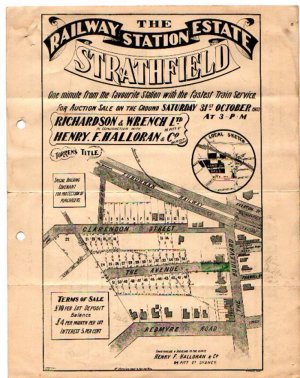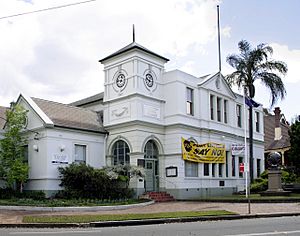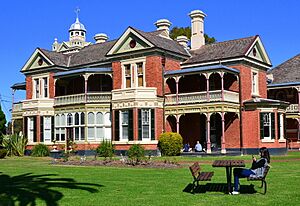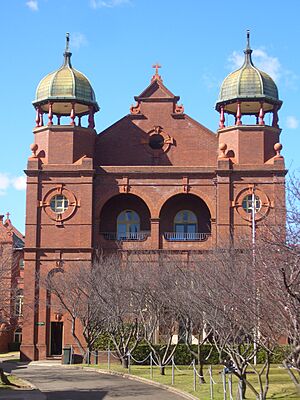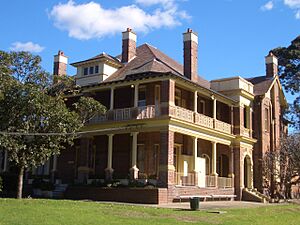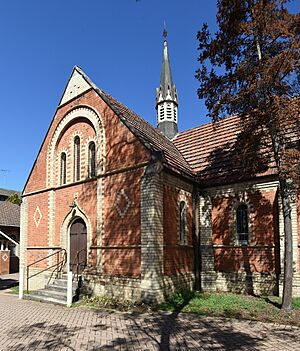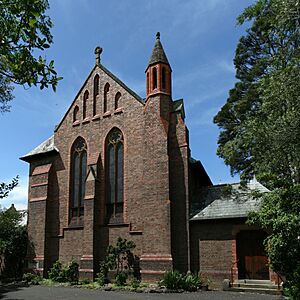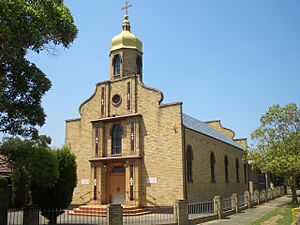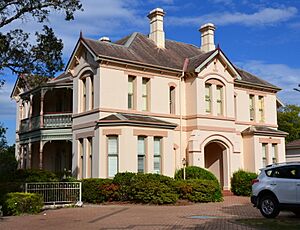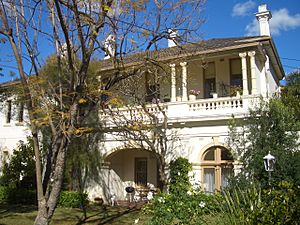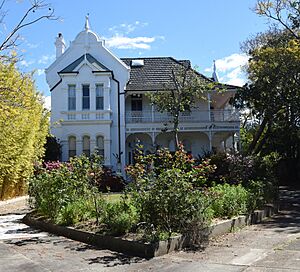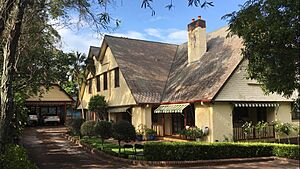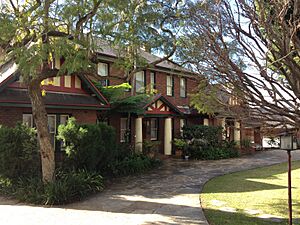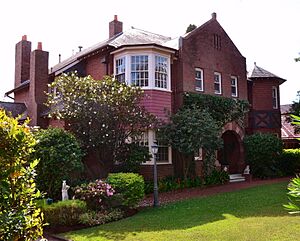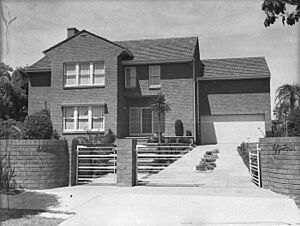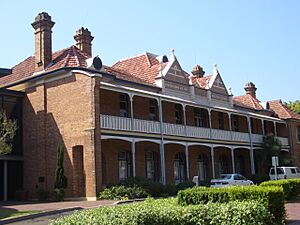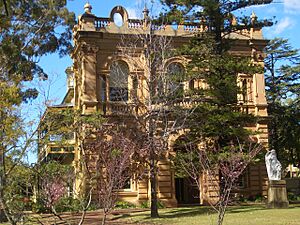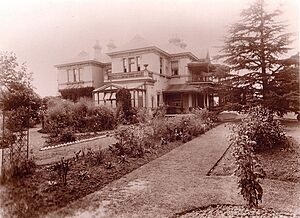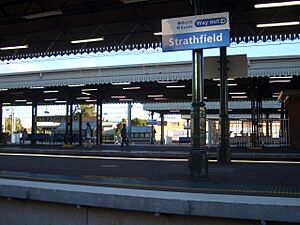Strathfield, New South Wales facts for kids
Quick facts for kids StrathfieldSydney, New South Wales |
|||||||||||||||
|---|---|---|---|---|---|---|---|---|---|---|---|---|---|---|---|
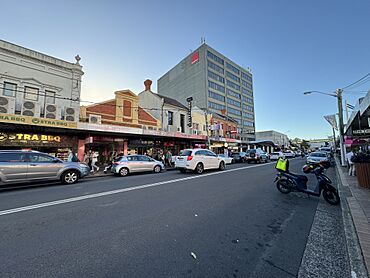
The Boulevarde
|
|||||||||||||||
| Established | c.1868 | ||||||||||||||
| Postcode(s) | 2135 | ||||||||||||||
| Elevation | 20 m (66 ft) | ||||||||||||||
| Area | 6.57 km2 (2.5 sq mi) | ||||||||||||||
| Location | 11.5 km (7 mi) west of Sydney CBD | ||||||||||||||
| LGA(s) |
|
||||||||||||||
| State electorate(s) | Strathfield | ||||||||||||||
| Federal Division(s) | |||||||||||||||
|
|||||||||||||||
Strathfield is a suburb in the Inner West of Sydney, New South Wales, Australia. It is about 12 kilometres west of the main city centre of Sydney. Strathfield is the main administrative hub for the Municipality of Strathfield. A small part of the suburb is in the City of Canada Bay, and another part is in the Municipality of Burwood. Nearby suburbs like North Strathfield and Strathfield South are separate places.
Contents
History of Strathfield
The land where Strathfield now stands was first home to the Wangal Indigenous Australians tribe. European settlers arrived in 1793 when land grants were given out. In 1808, James Wilshire received a large land grant that covers most of modern-day Strathfield.
In 1867, this land was divided and sold as the 'Redmire Estate'. This led to homes being built in the area, which was then called 'Redmire'. By 1885, enough people lived there to create their own local government. The suburb of Redmire was renamed Strathfield around 1886. It was named after a house called 'Strathfield House', which was originally known as Stratfield Saye. The Strathfield Council was officially formed in 1885.
James Wilshire received his land grant from Governor Macquarie in 1808. In 1824, the land was sold to Samuel Terry. It became known as the Redmire Estate. The name 'Redmire' might have come from a town in Yorkshire or from the red clay found in the Strathfield area.
Building on the land started in 1867. An early buyer was Walter Renny, a former Mayor of Sydney. In 1868, he built a house called Stratfieldsaye. This name might have been inspired by the Duke of Wellington's mansion in England. A small plaque on Strathfield Avenue marks where Stratfield Saye once stood. The house's name was later shortened to 'Strathfield House', and then just 'Strathfield'.
Strathfield became an official suburb on June 2, 1885. This happened after people living in the Redmyre area asked the New South Wales government for it. The name Strathfield was likely chosen to help end friendly rivalries between the nearby areas of Homebush and Redmire.
Strathfield Council's Growth
The Strathfield Council was formed in 1885. It included the suburbs of Redmire, Homebush, and Druitt Town (now part of Strathfield South). In 1892, the nearby area of Flemington joined Strathfield Council, making it about 50% larger. The Council had three sections called wards: Flemington, Homebush, and Strathfield. People called Aldermen were chosen to represent each ward. These wards were removed in 1916. In 1920, Strathfield Council was one of the first to declare most of its area a residential district, meaning it was mainly for homes.
Heritage-Listed Places
Strathfield has several places that are important for their history and are protected. These include:
- 25A Barker Road: Mount St Mary Campus of the Australian Catholic University
- Great Southern and Western railway: Strathfield rail underbridges
- Great Southern and Western railway: Strathfield railway station
- 62 The Boulevarde: Trinity Uniting Church, Strathfield
Education in Strathfield
Strathfield is known for having many schools and colleges.
There are two government high schools in Strathfield: Strathfield Girls High School and Strathfield South High School. Strathfield Girls High School serves areas like Concord West, Homebush West, and parts of Burwood. Strathfield South High School is for both boys and girls. It covers the southern part of Strathfield and suburbs like Chullora, Greenacre, and Belfield. A boys' high school is located nearby in Homebush.
Strathfield also has two government primary schools: Marie Bashir Public School and Strathfield South Public School. Homebush Public School and Strathfield North Public School are nearby and also serve parts of Strathfield. Chalmers Road Public School in Strathfield is a special school for students aged four to eighteen with intellectual disabilities.
Many independent or church-affiliated schools are also in Strathfield:
- St Patrick's College is a Catholic school for boys.
- Santa Sabina College is a Catholic school for girls from Kindergarten to Year 12, and for boys from Kindergarten to Year 4. Its primary school is called Santa Maria Del Monte.
- Meriden Anglican School for Girls is an Anglican school for girls.
- Trinity Grammar School Preparatory School has classes from Pre-Kindergarten to Year 6.
- St Martha's Primary School is a Catholic primary school.
Strathfield is also home to a large campus of the Australian Catholic University. The Seminary of the Good Shepherd, which trains Catholic priests, is located on the border of Strathfield and Homebush. The Catholic Institute of Sydney, where priests and other religious leaders are trained, is also in Strathfield.
Religious Buildings
You can find many different churches in Strathfield, including:
- Carrington Avenue Uniting Church
- Trinity Uniting Church, Strathfield
- St Andrew's Anglican Church
- St Anne's Anglican Church
- St David's Presbyterian Church
- St Martha's Catholic Church
- Sts Peter and Paul Russian Orthodox Cathedral
- Ukrainian Autocephalic Orthodox Church
- Strathfield Korean Uniting Church
- Sydney Chinese Seventh-day Adventist Church
- Western Sydney Chinese Christian Church
Built Environment
Strathfield has always been a popular suburb for people looking for nice homes in Sydney. Even though other areas like the Eastern Suburbs became more popular, Strathfield kept its wide streets, big houses, and good schools.
The homes in Strathfield are very different. You can find everything from large country-style estates to tall apartment buildings. Many different building styles have been used over the years, including Victorian, Federation, and Californian Bungalow styles.
One of the oldest houses still standing is Fairholm, built in the 1870s. It is now a retirement village called Strathfield Gardens. Many older homes have been replaced by modern, expensive mansions. However, Strathfield has kept its wide streets and lots of trees and plants. Streets like Victoria Street, Llandillo Avenue, and Kingsland Road still have many older mansions.
Near Homebush Road, you can find beautiful tree-lined streets with grand, historic houses from the late 1800s and early 1900s. Albert Road was once known as one of Sydney's most fancy streets, with many famous mansions. Redmyre Road is another wide street with many Victorian and Federation-era houses.
A special area known as the "Golden Mile" is found in the southeast, near Hunter Street and The Boulevarde. This area has some of the most desired homes in Strathfield. As land has been divided into smaller blocks, more people now live in apartments, especially near Strathfield railway station, where there are many tall residential towers. Smaller apartment buildings from the 1960s and 1970s are also found in other parts of the suburb.
Over the last century, some grand Strathfield homes became school campuses:
- Holyrood – Santa Sabina
- Brunyarra – Santa Maria Del Monte
- Lauriston – Santa Maria Del Monte
- Llandilo – Trinity Grammar School
- Somerset – Trinity Grammar School
- Milverton – Trinity Grammar School
- Riccarton/The Briars – Meriden
- Lingwood/Branxton – Meriden School
Commercial Areas
Strathfield's main shopping and business area is around a town square, just south of the train station. It includes the Strathfield Plaza shopping centre, which has a Woolworths and other shops. There are also many cafes, restaurants, and stores around the square and along Albert Road, Churchill Avenue, Redmyre Road, and The Boulevarde.
Strathfield's town centre is especially known for its many Korean restaurants and shops. This area is often called Little Korea.
Other smaller shopping areas are located north of the station and along the southern edge of the suburb. There are also car dealerships and other businesses along Parramatta Road and Liverpool Road, which are on the northern and southern borders of Strathfield.
Famous Residents
Many interesting people have lived in Strathfield over the years:
Architecture
- Harry Kent (1852–1938), an architect who designed the Strathfield Town Hall.
Business
- William Arnott, who started the famous Arnott's Biscuits company.
- Charles Henry Hoskins (1851-1926), an important industrialist and businessman.
- Edward Lloyd Jones (1844–1894), who led the department store David Jones Limited. His sons, Edward Lloyd Jones (1874–1934) and Charles Lloyd Jones (1878–1958), also led David Jones Limited.
Medicine
- Sir Philip Sydney Jones (1836–1918), a doctor and vice-chancellor of the University of Sydney.
Entertainment
- Bang Chan, a member and leader of the South Korean boy band Stray Kids, lived in Strathfield during his teenage years.
Sport
- Alan Davidson (1929−2021), a famous cricketer.
- Daphne Akhurst (1903–1933), a well-known tennis player.
Transport in Strathfield
Strathfield railway station is a very important train station. It is a major hub for both local Sydney trains and longer-distance trains. For many years, it was a stop for trains going to different parts of Sydney, as well as intercity and interstate services. However, since 2013, fewer long-distance trains stop here. The bus station, located near the town square, is also a major hub for buses serving the Inner West.
On the west side, Strathfield is bordered by the A3 arterial road. This road connects Strathfield to the St George region in the south and to places like Ryde and Pymble in the north.
Strathfield is also bordered by two other major roads: the Great Western Highway (Parramatta Road) to the north and the Hume Highway (Liverpool Road) to the south. The Great Western Highway goes east towards the Sydney city centre and west towards Parramatta and beyond. The Hume Highway goes east to Ashfield and west to Bankstown, Liverpool, and even to Canberra and Melbourne.
Population and Diversity
| Historical population | ||
|---|---|---|
| Year | Pop. | ±% |
| 2001 | 20,567 | — |
| 2006 | 20,481 | −0.4% |
| 2011 | 23,639 | +15.4% |
| 2016 | 25,813 | +9.2% |
| 2021 | 25,915 | +0.4% |
According to the 2021 census, Strathfield had a population of 25,915 people. This was a small increase from 2016.
Strathfield's easy train access and many apartment buildings near the station have made it a popular place for people from different countries to live. While many Korean restaurants and shops are near the station, making some think of Strathfield as a "Korean suburb," only a small part of the residents are actually of Korean background. Many people from the Korean community in Sydney travel to Strathfield just to visit the shops and restaurants.
In 2021, about 34.6% of people living in Strathfield were born in Australia. The next most common countries of birth were Nepal (13.6%), China (8.6%), India (6.8%), South Korea (6.2%), and Vietnam (3.1%).
About 29.4% of people speak only English at home. Other common languages spoken at home include Nepali (12.9%), Mandarin (9.3%), Cantonese (7.2%), and Korean (7.1%). For religion, the most common answers were No Religion (23.1%), Catholic (21.8%), Hinduism (20.8%), and Buddhism (7.2%).
Culture
Strathfield has played a part in the indie rock and indie pop music scenes. Bands like Prince Vlad & the Gargoyle Impalers and The Mexican Spitfires came from here. The Mexican Spitfires even wrote a song called "Rookwood" about Rookwood Cemetery. The famous punk rock band Radio Birdman's song "Murder City Nights" was also inspired by the area. Indie pop musician Grant McLennan from The Go-Betweens also lived in Strathfield for a few years.


